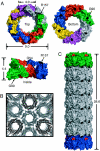In vitro self-assembly of tailorable nanotubes from a simple protein building block
- PMID: 18310321
- PMCID: PMC2268831
- DOI: 10.1073/pnas.0712247105
In vitro self-assembly of tailorable nanotubes from a simple protein building block
Abstract
We demonstrate a method for generating discretely structured protein nanotubes from the simple ring-shaped building block, homohexameric Hcp1 from Pseudomonas aeruginosa. Our design exploited the observation that the crystal lattice of Hcp1 contains rings stacked in a repeating head-to-tail pattern. High-resolution detail of the ring-ring interface allowed the selection of sites for specific cysteine mutations capable of engaging in disulfide bond formation across rings, thereby generating stable Hcp1 nanotubes. Protein nanotubes containing up to 25 subunits ( approximately 100 nm in length) were self-assembled under simple conditions. Furthermore, we demonstrate that the tube ends and interior can be independently and specifically functionalized to generate nanocapsules.
Conflict of interest statement
Conflict of interest statement: A preliminary patent detailing these findings has been filed.
Figures




References
-
- Lee SW, Mao C, Flynn CE, Belcher AM. Ordering of quantum dots using genetically engineered viruses. Science. 2002;296:892–895. - PubMed
-
- Mao C, et al. Virus-based toolkit for the directed synthesis of magnetic and semiconducting nanowires. Science. 2004;303:213–217. - PubMed
-
- Huang Y, et al. Programmable assembly of nanoarchitectures using genetically engineered viruses. Nano Lett. 2005;5:1429–1434. - PubMed
-
- Nam KT, et al. Virus-enabled synthesis and assembly of nanowires for lithium ion battery electrodes. Science. 2006;312:885–888. - PubMed
-
- Mukherjee S, Pfeifer CM, Johnson JM, Liu J, Zlotnick A. Redirecting the coat protein of a spherical virus to assemble into tubular nanostructures. J Am Chem Soc. 2006;128:2538–2539. - PubMed
Publication types
MeSH terms
Substances
LinkOut - more resources
Full Text Sources
Other Literature Sources
Molecular Biology Databases

